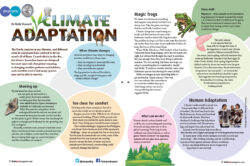
How animals are adapting to the changing climate

The Earth contains many climates, and different animals and plants have evolved to live in nearly all of them. Camels thrive in the dry, hot desert. Snowshoe hares are designed for snow and cold. But global warming is changing weather patterns and habitats, and scientists worry that many species may not be able to survive.
When Climate Changes
Animals and plants may adapt to changing weather conditions in three ways:
• they can migrate to more suitable areas
• they can adapt as individuals• they can evolve as a species
The big question is who will be able to adapt quickly enough to keep pace with today’s climate change?
Moving Up
If your home becomes too hot, you can pack up and move to a cooler place. And some animals are doing just that. But scientists were afraid that the Quino checkerspot butterfly in California was doomed. Why? Because the caterpillars of this endangered butterfly only eat one plant, and its normal territory has become too hot and dry for this plant to grow. What’s worse, the checkerspot’s path to cooler ground is blocked by the sprawling city of Los Angeles.
Recently, scientists were amazed to find that some Quino checkerspots have somehow found their way past the city to higher, cooler land. Not only that, they are laying their eggs on a new host plant and the caterpillars are eating it!
Too Close for Comfort
Unfortunately, when animals are forced to move, the results are not always so good.
Imagine you live on the 10th floor of a 15-storey apartment building. What if all the people who lived above you decided to move down to your floor? Your living space would become cramped.
That’s what’s starting to happen in the Philippine rain forest. Rain forests are kind of like apartment buildings – there are animals that live at every level. But because the lower levels are cooler, some of the animals from the top (canopy) are moving down to escape the heat. As more and more animals move downward, overcrowding could seriously damage this habitat.
Magic Frogs
We think of evolution as something that happens very slowly, but that’s not always true. Take the green tree frogs that live on North Carolina’s coast.
Climate change has caused rising sea levels, and that has turned some of the freshwater marshes where this frog lives salty. The problem is, frogs can’t live in salt water because the salt makes them lose water from inside their bodies. At least, that’s true of the inland frogs.
When Molly Albecker, a PhD student at East Carolina University, heard frogs singing out in the salt marsh one night, her advisor first thought she must be mistaken. But sure enough there they were, living in saltwater marshes. “It’s very exciting that these tree frogs can adapt to something that is considered so deadly,” says Molly. “It makes us wonder whether some other freshwater species may develop the same ability.”
Molly encourages people (including kids) to get involved in “citizen science.” One way is to use websites like inaturalist.ca to record the wildlife they spot. “Just being curious can lead to some pretty big discoveries,” suggests Molly.
Time Shift
Migration – when animals travel (sometimes long distances) to breed or spend the winter – is a behaviour that is written into the genes. That can be bad news if animals aren’t able to adjust their timing or their route when conditions change.
The pink salmon is one species that has been able to change the time of its migration to match new climate patterns. Salmon normally live in the ocean, but in spring and early summer they swim up freshwater streams to lay their eggs. In Auke Creek, Alaska, their spring migration has shifted earlier by about two weeks over the past 40 years. Over that same time, the stream’s water temperature has increased — so it seems the salmon have tweaked their schedule to give their eggs the best hatching temperature. It looks like it’s working: the Auke Creek salmon population is holding steady.
Human Adaptation
Climate conditions affect people too. Can people adapt to different kinds of weather? The Inuit have lived in the North American Arctic and Greenland for thousands of years. They have developed a body type that helps them survive in extreme cold. Shorter arms, legs, and fingers/toes reduce heat loss. Fat pads over the sinuses help warm the air they breathe, and a higher percentage of body fat generates more heat.
In many parts of the world, humans now rely on tools and technology – like clothing, heating, and air-conditioning – to protect them against extreme climate conditions. In fact, our physical features are no longer very important to our survival.
What can we do?
Forests absorb carbon dioxide and cool the air, so protecting and renewing forests is an important way to slow global warming. Protecting forests, wetlands and other habitats, as well as green “travel corridors” for migrating animals will also give more species a chance to survive.
